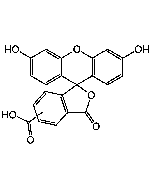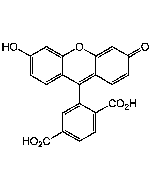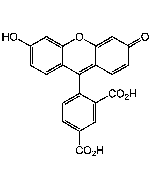Cookie Policy: This site uses cookies to improve your experience. You can find out more about our use of cookies in our Privacy Policy. By continuing to browse this site you agree to our use of cookies.
Chemodex
5(6)-FAM N-succinimidyl ester

| Product Details | |
|---|---|
| Synonyms | 5(6)-Carboxyfluorescein NHS ester (mixture of isomers); 5(6)-CFSE; 5(6)-FAM SE; FLUOS |
| Product Type | Chemical |
| Properties | |
| Formula |
C25H15NO9 |
| MW | 473.4 |
| CAS | 117548-22-8 |
| Source/Host Chemicals | Synthetic. |
| Purity Chemicals | ≥98% (HPLC) |
| Appearance | Yellow to orange powder. |
| Solubility | Soluble in DMSO or dimethylformamide. |
| Declaration | Manufactured by Chemodex. |
| Other Product Data |
Click here for Original Manufacturer Product Datasheet |
| InChi Key | STUDUJDWFUAOEN-UHFFFAOYSA-N |
| Smiles | OC1=CC=C2C(OC(C3=C2C4=C(C(O)=O)C=CC=C4)=CC(C=C3)=O)=C1.CC(ON5C(CCC5=O)=O)=O |
| Shipping and Handling | |
| Shipping | AMBIENT |
| Short Term Storage | +4°C |
| Long Term Storage | -20°C |
| Handling Advice |
Keep cool and dry. Protect from light and moisture. |
| Use/Stability | Stable for at least 2 years after receipt when stored at -20°C. |
| Documents | |
| Product Specification Sheet | |
| Datasheet |
 Download PDF Download PDF |
Fluorescent probe and cell staining dye. Reacts with primary and secondary amine groups on proteins and other biomolecules. Cell permeable and covalently couples, via its succinimidyl group, to intracellular molecules. Due to this covalent coupling reaction fluorescent CFSE can be retained within cells for extremely long periods. Used for immunological studies to monitor the proliferation of many cell types (including lymphocytes, fibroblasts) and even bacteria. Has been used to prepare fluorescent derivatives of tubulin and for the preparation of a phenytoin tracer for the determination of this drug in serum and plasma by fluorescence polarization immunoassay (FPIA). Favored over FITC in bioconjugations, since FAM reagents are more resistant to hydrolysis. In addition, FAM reagents require less stringent conjugation conditions and give better conjugation yields, and the resulted conjugates have superior stability. Spectral properties: λex= 492; λem=517nm in DMF or 0.1 M Tris, pH 8.0.
(1) P.R. Banks & D.M. Paquette; Bioconjug. Chem. 6, 447 (1995) | (2) P. Breeuwer, et al.; Appl. Environ. Microbiol. 62, 178 (1996) | (3) D. Fulcher & S. Wong; Immunol. Cell Biol. 77, 559 (1999) | (4) T. Sathiyaseelan & C.L. Baldwin; Res. Vet. Sci. 69, 275 (2000) | (5) I. Tsuge, et al.; Allergol. Int. 56, 149 (2007)










